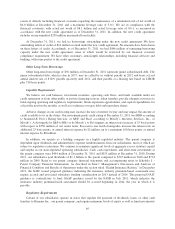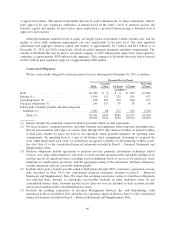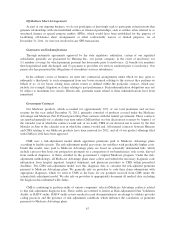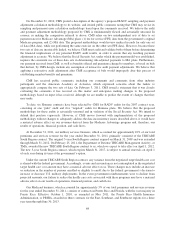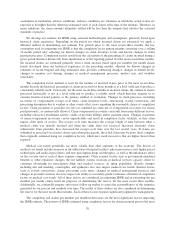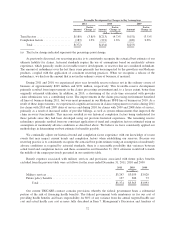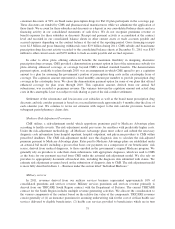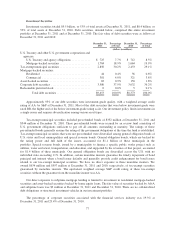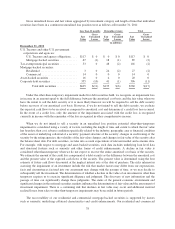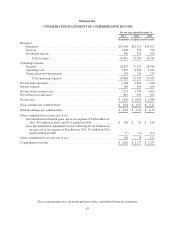Humana 2011 Annual Report Download - page 85
Download and view the complete annual report
Please find page 85 of the 2011 Humana annual report below. You can navigate through the pages in the report by either clicking on the pages listed below, or by using the keyword search tool below to find specific information within the annual report.consumer discounts of 50% on brand name prescription drugs for Part D plan participants in the coverage gap.
These discounts are funded by CMS and pharmaceutical manufacturers while we administer the application of
these funds. We account for these subsidies and discounts as a deposit in our consolidated balance sheets and as a
financing activity in our consolidated statements of cash flows. We do not recognize premiums revenue or
benefit expenses for these subsidies or discounts. Receipt and payment activity is accumulated at the contract
level and recorded in our consolidated balance sheets in other current assets or trade accounts payable and
accrued expenses depending on the contract balance at the end of the reporting period. Gross financing receipts
were $2.5 billion and gross financing withdrawals were $2.9 billion during 2011. CMS subsidy and brand name
prescription drug discount activity recorded to the consolidated balance sheets at December 31, 2011 was $363
million to other current assets and $139 million to trade accounts payable and accrued expenses.
In order to allow plans offering enhanced benefits the maximum flexibility in designing alternative
prescription drug coverage, CMS provided a demonstration payment option in lieu of the reinsurance subsidy for
plans offering enhanced coverage, or coverage beyond CMS’s defined standard benefits. The demonstration
payment option, available to plans through 2010, was an arrangement in which CMS agreed to pay a capitation
amount to a plan for assuming the government’s portion of prescription drug costs in the catastrophic layer of
coverage. The capitation amount represented a fixed monthly amount per member to provide prescription drug
coverage in the catastrophic layer. We chose the demonstration payment option for some of our plans that offered
enhanced coverage for plan years through 2010. This capitation amount, derived from our annual bid
submissions, was recorded as premiums revenue. The variance between the capitation amount and actual drug
costs in the catastrophic layer was subject to risk sharing as part of the risk corridor settlement.
Settlement of the reinsurance and low-income cost subsidies as well as the brand name prescription drug
discounts and risk corridor payment is based on a reconciliation made approximately 9 months after the close of
each calendar year. We continue to revise our estimates with respect to the risk corridor provisions based on
subsequent period pharmacy claims data.
Medicare Risk-Adjustment Provisions
CMS utilizes a risk-adjustment model which apportions premiums paid to Medicare Advantage plans
according to health severity. The risk-adjustment model pays more for enrollees with predictably higher costs.
Under the risk-adjustment methodology, all Medicare Advantage plans must collect and submit the necessary
diagnosis code information from hospital inpatient, hospital outpatient, and physician providers to CMS within
prescribed deadlines. The CMS risk-adjustment model uses this diagnosis data to calculate the risk-adjusted
premium payment to Medicare Advantage plans. Rates paid to Medicare Advantage plans are established under
an actuarial bid model, including a process that bases our payments on a comparison of our beneficiaries’ risk
scores, derived from medical diagnoses, to those enrolled in the government’s original Medicare program. We
generally rely on providers to code their claim submissions with appropriate diagnoses, which we send to CMS
as the basis for our payment received from CMS under the actuarial risk-adjustment model. We also rely on
providers to appropriately document all medical data, including the diagnosis data submitted with claims. We
estimate risk-adjustment revenues based on the submission of diagnosis data to CMS. The risk-adjustment model
is more fully described in Item 1. – Business under the section titled “Individual Medicare.”
Military services
In 2011, revenues derived from our military services business represented approximately 10% of
consolidated premiums and services revenue. Military services premiums and services revenue primarily is
derived from our TRICARE South Region contract with the Department of Defense. The current TRICARE
contract for the South Region includes multiple revenue generating activities. We allocate the consideration to
the various components of the contract based on the relative fair value of the components. TRICARE revenues
consist generally of (1) an insurance premium for assuming underwriting risk for the cost of civilian health care
services delivered to eligible beneficiaries; (2) health care services provided to beneficiaries which are in turn
75


